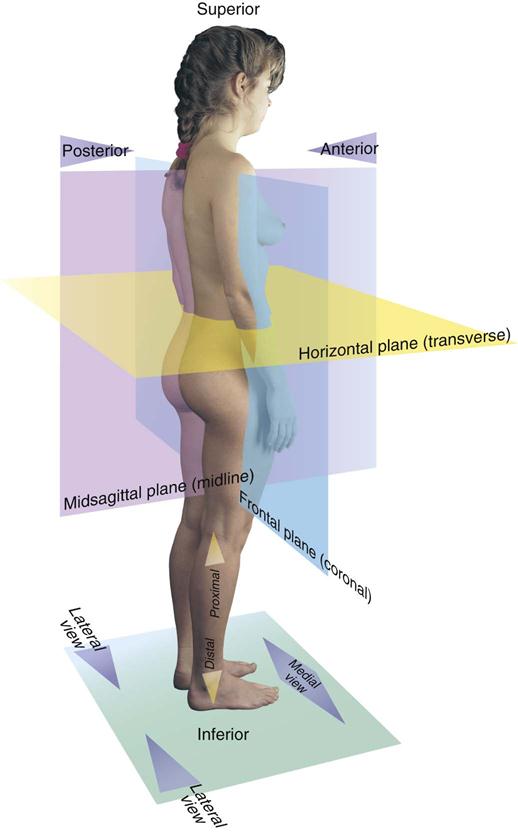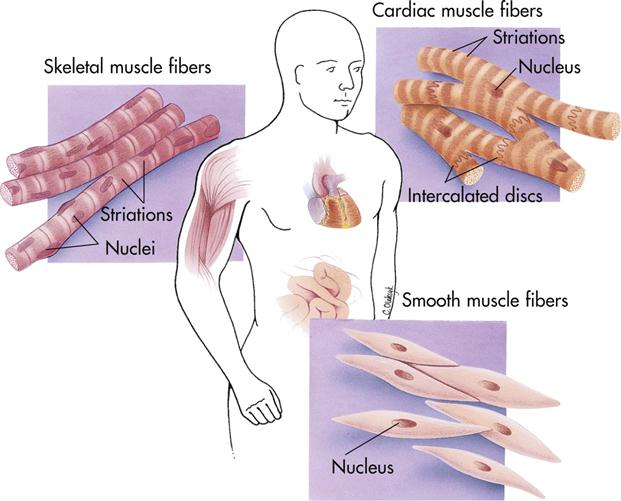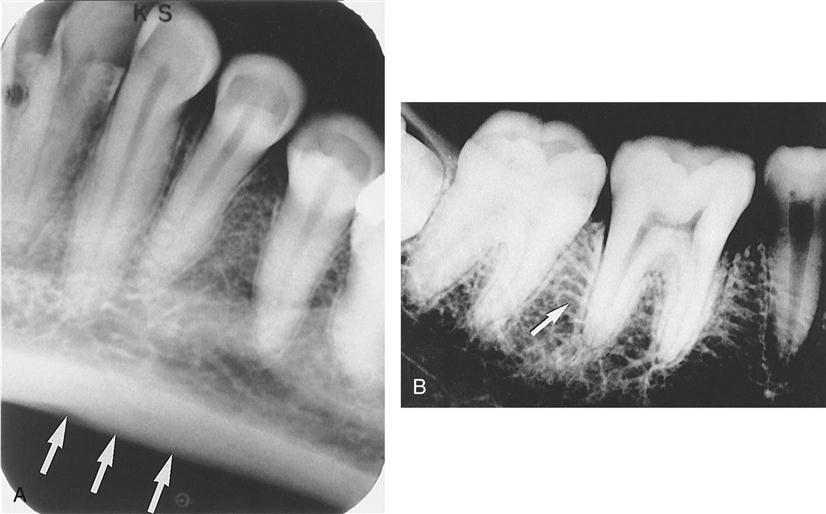Anatomy and Physiology
Learning Objectives
1 Pronounce, define, and spell the Key Terms.
2 Name and describe the term used to describe body directions.
3 List the organizational levels of the human body.
4 Name each body system and identify its major function.
5 Explain why a dental assistant should be familiar with the structure of the head and neck.
6 Identify the major muscles of mastication and facial expression and state the function of each.
7 Name and locate the landmarks of the face and oral cavity.
Key Terms
Ala of the Nose
Alveolar Socket
Anatomy
Angle of the Mandible
Anterior
Anterior Naris
Attached Gingivae
Buccal
Canthus
Cells
Distal
Frontal Plane
Glabella
Inferior
Innervation
Lateral
Lingual
Mandibular
Masticatory Mucosa
Maxillary
Medial
Mental Protuberance
Midsagittal Plane
Mucogingival Junction
Mucous Membrane
Nasion
Organs
Palate
Philtrum
Physiology
Posterior
Proximal
Sagittal Plane
Septum
Superior
Tissues
Tragus
Transverse Plane
Trigeminal Nerve
Zygomatic Arch
The human body is an incredible living creation. It has 11 body systems that function together more smoothly than the world’s greatest computers. It is important for the dental assistant to have a basic understanding of the study of anatomy (the study of the structure of the human body) and physiology (the study of how the human body functions). This knowledge will also help you to keep your own body healthy, communicate with medical personnel, and understand treatments or medications that may be prescribed for you. This chapter also introduces you to the basic terms and definitions that you need to communicate effectively as a dental healthcare professional.
Directions and Body Planes
Directions in the Body
Directional terms are used to describe the relative position of one part of the body to another. Note that the pairs of directional terms in Table 3-1 are opposites (i.e., left/right, up/down, and forward/back).
TABLE 3-1
Directional Terms for the Body
< ?comst?>
| Term | Example | Term | Example |
| Anterior: toward the front of the body | The heart is anterior to the spinal column. | Posterior: toward the back of the body | The ear is posterior to the nose. |
| Medial: toward, or nearer to, the midline of the body | The nose is medial to the ears. | Lateral: toward the side, away from the midline | The ears are lateral to the nose. |
| Proximal: the part closer to the trunk of the body, or the point of attachment | The elbow is proximal to the wrist. | Distal: the part farther away from the midline of the body | The fingers are distal to the wrist. In dentistry, the surface of a tooth that is farthest from the midline is the distal surface. |
| Superior: above or higher | The nose is superior to the mouth. | Inferior: below or under | The nose is inferior to the eyes. |
< ?comen?>< ?comst1?>

< ?comst1?>
< ?comen1?>
Planes and Sections of the Body
Three imaginary planes are used to help visualize the spatial relationships of internal body parts. These planes are used to describe the location of an organ or a problem (Figure 3-1).
Organizational Levels of the Body
The human body has four organizational levels, or units. From the simplest to the most complex, they include cells, tissues, organs, and body systems (Figure 3-2).
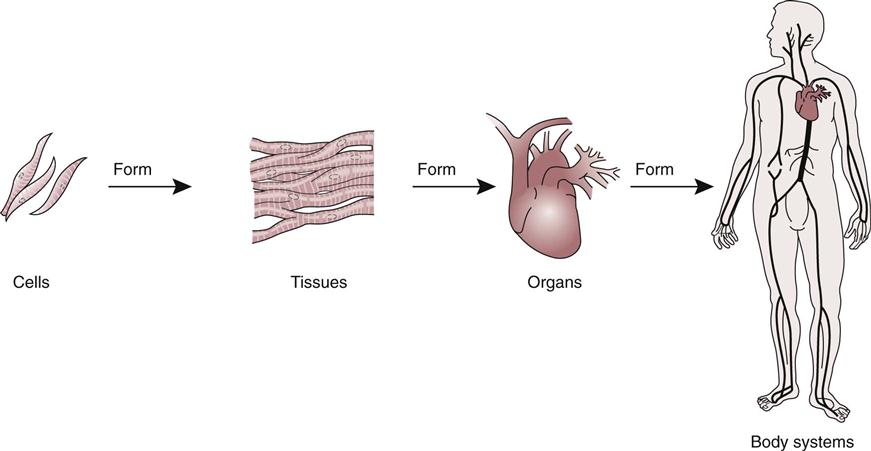
Cells
Cells are the smallest units in the human body. A variety of cell types are known, and each type has its own special functions. The structure of a particular cell is based on the function of that cell. For example, blood cells have a very different function from heart cells. Cells do not function alone. Approximately 75 to 100 trillion cells join together to form special groups known as tissues.
Tissues
Four main types of tissues are found in the human body: epithelial, connective, muscle, and nervous. Like cells, each type of tissue is designed to perform a specific function (Table 3-2). Related tissue types join together to form organs. For example, heart muscles function together to keep the heart beating.
TABLE 3-2
| Tissue | Function | Example |
| Epithelial | Forms the covering of all body surfaces and lines body cavities and hollow organs | Skin, intestines, lungs, tubes of the reproductive system, and lining of the oral cavity |
| Connective | Binds structures together; forms framework and support for organs and the entire body; stores fat, transports substances, and helps repair tissue damage | Fat, tendons and ligaments, cartilage, blood, and bone |
| Muscle | Produces movement of body parts | Body movements, pumping action of the heart, and moves food through the digestive process and urine through the bladder |
| Nervous | Found in the brain, spinal cord, and nerves; coordinates and controls many body activities | Stimulates muscle contraction; creates awareness of the environment; and plays a major role in emotions, memory, and reasoning |
Organs
Organs work together as a team to keep each body system functioning. The heart, skin, ear, stomach, and liver are examples of organs.
Body Systems
Body systems are made up of organs. Occasionally the same organ belongs to more than one system. For example, ovaries and testes clearly belong to the reproductive system, but because one of their functions is to produce hormones, they are also part of the endocrine system. Body systems do not function independently. For example, when you exercise hard, your muscular system needs extra oxygen. Your respiratory system meets this need by supplying additional oxygen.
Systems of the Body
Eleven major systems are present in the human body (Figure 3-3). Although each system has its own specific functions, all systems work together as a team to support life (Table 3-3).
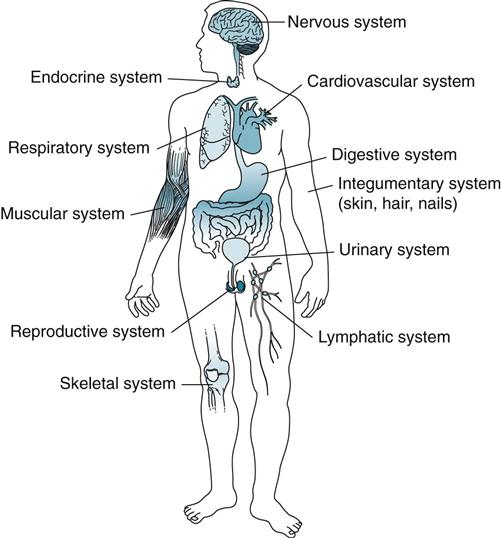
TABLE 3-3
| Body System | Components | Major Functions |
| Skeletal system | 206 bones | Protection, support, and shape; hematopoietic; storage of certain minerals |
| Muscular system | Striated, smooth, and cardiac muscle | Holding body erect, locomotion, movement of body fluids, production of body heat, communication |
| Cardiovascular system | Heart, arteries, veins, and blood | Respiratory, nutritive, excretory |
| Lymphatic and immune system | White blood cells; lymph fluid, vessels, and nodes; spleen and tonsils | Defense against disease, conservation of plasma proteins and fluid, lipid absorption |
| Nervous system | Central and peripheral nervous systems, special sense organs | Reception of stimuli, transmission of messages, coordinating mechanism |
| Respiratory system | Nose, paranasal sinuses, pharynx, epiglottis, larynx, trachea, bronchi, and lungs | Transport of oxygen to cells, excretion of carbon dioxide and some water wastes |
| Digestive system | Mouth, pharynx, esophagus, stomach, intestines, and accessory organs | Digestion of food, absorption of nutrients, elimination of solid wastes |
| Urinary system | Kidneys, ureters, bladder, and urethra | Formation and elimination of urine, maintenance of homeostasis |
| Integumentary system | Skin, hair, nails, sweat glands, and sebaceous glands | Protection of body, regulation of body temperature |
| Endocrine system | Adrenals, gonads, pancreas, parathyroids, pineal, pituitary, thymus, and thyroid | Integration of body functions, control of growth, maintenance of homeostasis |
| Reproductive system | Male: testes, penis Female: ovaries, fallopian tubes, uterus, vagina |
Production of new life |
The Digestive System
The digestive system is composed of the mouth, teeth, tongue, pharynx, esophagus, stomach, intestines, and glands such as the salivary glands, pancreas, and liver. The functions of the digestive system are to ingest food, process it into molecules that can be used by the body, and then eliminate the residue.
The Nervous System
The nervous system causes muscles to contract, stimulates glands to secrete, and regulates many other systems of the body. The nervous system also allows sensation such as pain, pressure, and touch to be perceived. The two main divisions of this system are the central nervous system, which consists of the spinal cord and brain, and the peripheral nervous system, which consists of the cranial and spinal nerves.
The Cardiovascular System
The cardiovascular system includes the heart, blood vessels, and blood. The functions of the cardiovascular system are to circulate blood, to carry oxygen and nutrients to all areas of the body, and to filter and eliminate wastes. The two major subdivisions of this system are the pulmonary circulation and the systemic circulation. The pulmonary circulation includes the flow of blood from the heart, through the lungs (where it receives oxygen), and back to the heart. Systemic circulation includes blood flow to all parts of the body except the lungs.
The Endocrine System
The endocrine system consists of glands that produce hormones that regulate the rate of metabolism, growth, and sexual development and functioning. Hormones are secreted directly into the bloodstream (not through a duct). The endocrine glands include the thyroid and parathyroid, ovaries, testes, pituitary, pancreas, and adrenal medulla.
The Respiratory System
The respiratory system is responsible for carrying oxygen from the air to the bloodstream and for expelling the waste product carbon dioxide. The respiratory system is composed of the nose, paranasal sinuses, pharynx, epiglottis, larynx, trachea, alveoli, and lungs.
The Lymphatic System
The lymphatic system is part of the immune system, and it plays an important role in the defense of the body against infection and disease. It also plays a role in the absorption of fats from the intestine. This system includes the thymus, spleen, tonsils, lymph vessels, lymph nodes, and lymphatic nodules located in the digestive system.
The Muscular System
The muscular system is composed of three basic types of muscles: striated (striped), smooth, and cardiac. These types of muscles are described according to their appearance and function (Figure 3-4).
Types of Muscle
Striated muscles are known as the skeletal or voluntary muscles. Skeletal muscles attach to the bones of the skeleton and make bodily motions possible.
Smooth muscle fibers move the internal organs, such as the digestive tract, blood vessels, and secretory ducts leading from the glands.
Cardiac muscle forms most of the wall of the heart, and it is the contraction of the muscle that causes the heart to beat.
The Skeletal System
The skeletal system is composed of 206 bones. It provides the framework for the attached muscles and plays an indispensable role in movement and in supporting the brain and spinal cord (which are encased in the skull and spine).
The Urinary System
The urinary system consists of the kidneys, in which urine is formed to carry away waste materials from the blood; the ureters, which transport urine from the kidney; the bladder, where the urine is stored until it can be disposed of; and the urethra, through which the bladder is emptied to the outside through the process of urination. The kidneys require a large blood supply and are close to the main artery of the body—the aorta. More than 2 pints of blood pass through the kidneys every minute.
The Integumentary or Skin System
The integumentary (skin) system has many important functions. It helps regulate body temperature, keeps bacteria from entering the body, excretes liquids and salts, and provides sensitivity to touch. The skin also absorbs ultraviolet rays from the sun and uses them to convert chemicals into vitamin D, which is necessary for absorption of calcium.
The Reproductive System
In the female, the reproductive system consists of the ovaries, fallopian tubes, uterus, and vagina. Fertility begins at puberty (the onset of menstruation) and ceases at the time of menopause. In the male, the reproductive system includes the testes, prostate, and seminal vesicles.
Structures of the Head and Neck
As a dental assistant, your knowledge and understanding of the structures of the head and neck will be useful for almost every task you perform (see Procedure 3-1 at the end of this chapter).
The Types of Bone
Bone is the hard connective tissue that makes up most of the human skeleton. There are two types of bone (Figure 3-5).
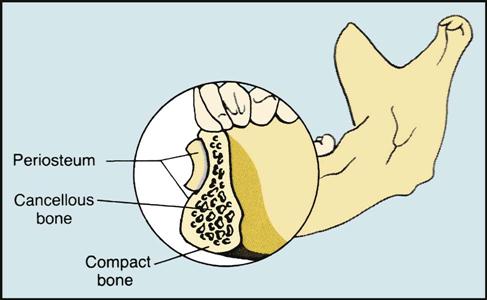
Compact bone, also known as cortical bone, is hard, dense, and very strong. It forms the outer layer of bones, where it is needed for strength. For example, the outer layer of the mandible (lower jaw) is made of compact bone (Figure 3-6).
Cancellous bone, also known as spongy bone, is lighter in weight and is not as strong as compact bone. It is found in the interior of bones. For example, the inner layer of the maxillary bones (upper jaw) is made of cancellous bone.
The periosteum is the specialized connective tissue covering of all bones in />
Stay updated, free dental videos. Join our Telegram channel

VIDEdental - Online dental courses


